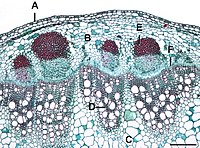
Photo from wikipedia
Secondary growth of the woody tree stem is governed by meristematic cell division and differentiation in the vascular cambium. Multiple hormonal signals and endogenous developmental programs regulate vascular cambium activity.… Click to show full abstract
Secondary growth of the woody tree stem is governed by meristematic cell division and differentiation in the vascular cambium. Multiple hormonal signals and endogenous developmental programs regulate vascular cambium activity. Brassinosteroids (BRs) significantly promote secondary stem growth and wood formation in poplar trees. However, the underlying regulatory mechanisms of BRs within the vascular tissue remain unclear. Genetic and anatomical approaches were used here to elucidate the role of PagDET2, the rate-limiting enzyme for BRs biosynthesis, in regulating secondary vascular cambium activity in Populus. This study showed that the elevated endogenous castasterone (CS) levels in tree stems through overexpressing PagDET2 could enhance cambium meristem cell activity and xylem (XY) differentiation to promote secondary stem growth. RNA-seq analysis revealed that genes involved in BRs response, vascular cambium cell division, XY differentiation, and secondary cell wall synthesis were up-regulated.
Journal Title: Frontiers in Plant Science
Year Published: 2022
Link to full text (if available)
Share on Social Media: Sign Up to like & get
recommendations!